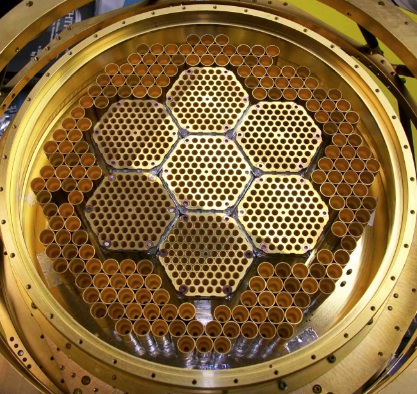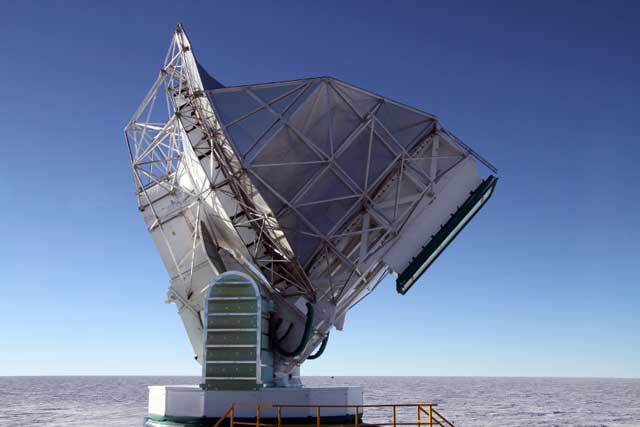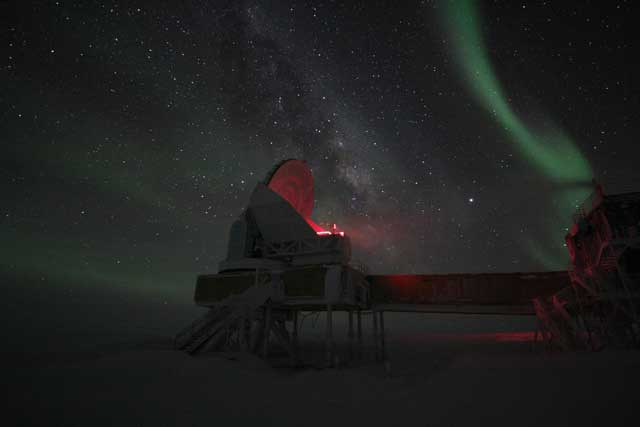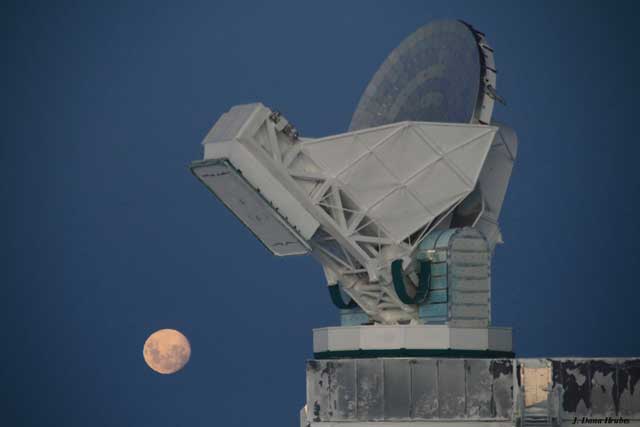|
New mode of discoverySouth Pole Telescope detects polarization pattern in Big Bang afterglowPosted September 20, 2013
Scientists using the South Pole Telescope (SPT) This measurement, detailed in a recent paper by the SPT collaboration Located at the geographic South Pole, the SPT is a large millimeter-wavelength telescope designed to observe the cosmic microwave background (CMB) This intense visible light — red-shifted or stretched by the expansion of the universe since that time — is detectable today as an extremely weak microwave signal. This signal provides a “snapshot” of the primordial universe and contains a wealth of information concerning both fundamental physics and cosmology, such as the geometry, content, evolution, and even destiny of the universe. While the South Pole may seem an inhospitable place to most, it provides one of the best sites for achieving the ambitious goals of the SPT project. Since moisture in the atmosphere absorbs microwaves, the thin, cold, dry atmosphere above the South Pole allows the SPT to more easily detect the CMB radiation. The air is so cold that there is very little moisture in it, and at about 9,300 feet elevation, there is much less atmosphere to look through. SPT, which began observations in 2007, used a very sensitive camera that could measure the extremely small spatial temperature distribution or anisotropy of the CMB at three millimeter-wavelength bands. This first phase, completed in November 2011, had produced the highest resolution, highest sensitivity map of the CMB at that time. [See previous article — Mission complete: South Pole Telescope finishes five-year survey of galaxy clusters.] The telescope has also discovered hundreds of massive high-redshift galaxy clusters (the most massive gravitationally bound entities in the universe), point sources including high-redshift dusty star-forming galaxies, and dust-obscured active galactic nuclei. [See previous article — Cluster of discoveries: South Pole Telescope finds fastest star-making region in the universe.] These measurements have allowed the SPT collaboration to understand better the physics of the universe. The high-resolution map of the CMB anisotropy has led to improvements of the CMB power spectrum. The CMB power spectrum is essentially the sound spectrum in the hydrogen-helium plasma of the primordial universe. It is used to quantify a number of properties of the observable universe. 
Photo Credit: South Pole Telescope website
Focal plane for the South Pole Telescope polarization-sensitive camera.
A catalog of massive galaxy clusters over a range of redshift is allowing us to better constrain cosmological parameters such as the equation of state of dark energy Examining objects over a large range of redshifts gives us a look at how gravitationally bound structures evolved over time, helping us to understand better how the mysterious force dubbed dark energy has influenced the expansion history of the universe. In January 2012, the SPT was equipped with a new polarization-sensitive camera, SPTpol, to add to the capabilities of the telescope. SPTpol is a dual-frequency polarization-sensitive camera sensitive to two millimeter-wavelength bands that will continue the original SPT science goals, and, in addition, measure the polarization anisotropy of the CMB. Polarization of the CMB light essentially means that the light waves have a preferential rather than random direction of oscillation. The polarization signal imprinted on the CMB can be decomposed into what are commonly referred to as “E-mode” (gradient-like) and “B-mode” (curl-like) signals, which are analogous to the “E” and “B” field patterns in electromagnetism. Measuring the CMB takes extremely sensitive cameras with very low noise to measure variations in the 2.7 degree Kelvin (2.7 degrees above absolute zero) CMB. The temperature anisotropy across the CMB is one part in 100,000, requiring measurements of temperature differences of several hundred-thousandths of a degree. 
Photo Credit: Dana Hrubes
The South Pole Telescope in 2013 with new receiver, primary mirror shroud and larger ground shield.
The B-mode polarization anisotropy that was first measured with the SPT is 100 times fainter or about one part in 10 million. That means that we are measuring incredibly tiny differences in the 2.7 degree Kelvin CMB. E-mode polarization, essentially created by the fluctuations in density of the hydrogen-helium plasma in the early universe, was first measured with the DASI telescope B-mode polarization can be created in two ways: B-mode conversion of E-mode polarization by gravitational lensing and direct CMB polarization by inflationary gravity waves. In mode conversion, E-mode polarized CMB light that has traveled through space for about 13.7 billion years to reach us is gravitationally lensed or distorted into B-mode polarized light as it travels past massive galaxy clusters. These lensed B-modes can be used to better constrain cosmological parameters, such as the matter distribution in the universe and the masses of neutrinos. This is the B-mode polarization in the CMB that the SPT collaboration was recently the first to detect. One of the next and even larger goals is to measure the B-mode polarization of the CMB created by gravity waves from the inflationary period the initial, short-lived exponential expansion or the “bang” in the Big Bang. These are B-modes directly imprinted on the CMB by gravitational waves generated during this theorized inflationary period. Detection of this primordial B-mode polarization would confirm the theory of inflation, the theory that provides a basis for the hot Big Bang model of the universe. SF-funded research in this article: John Carlstrom, John Ruhl, Joseph Mohr, William Holzapfel and Nils Halverson, University of Chicago, Award No. 0638937 |



For USAP Participants |
For The Public |
For Researchers and EducatorsContact UsU.S. National Science FoundationOffice of Polar Programs Geosciences Directorate 2415 Eisenhower Avenue, Suite W7100 Alexandria, VA 22314 Sign up for the NSF Office of Polar Programs newsletter and events. Feedback Form |



